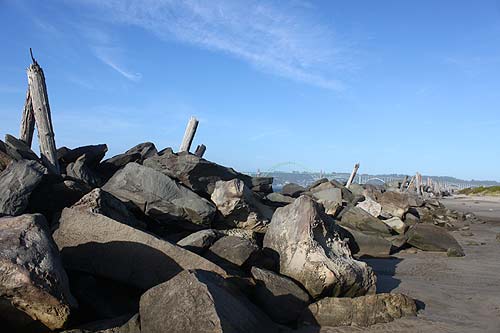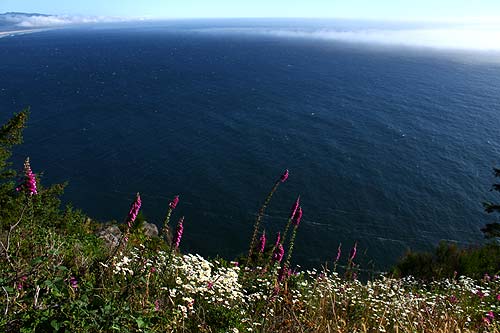Oregon Coast Science: Why No Tsunami with the Alaska Earthquake?
Published 01/23/2018 at 7:45 PM PDT - Updated 01/23/2018 at 10:45 PM PDT
By Oregon Coast Beach Connection staff

(Oregon Coast) – Early Tuesday morning saw something startling for Oregon coast residents: a tsunami watch issued because of a 7.9 earthquake off the Alaskan coast. After two or so tense hours, filled with some locals heading inland anyway, the watch was lifted and those who weren't still sleeping through it could rest easily.
Meanwhile, in Alaska things were not so laidback. Tsunami alert sirens went off in many parts of Alaska and even British Columbia, waking residents and calling for evacuations to higher ground. Those warnings were finally lifted too. However, a six-inch tsunami wave was recorded coming into one section of Alaska beach.
It all hearkened back to the great quake of 1964, which killed over 100 in Alaska and caused a tsunami wave that inundated Seaside, killed four children on a beach in Newport and washed out the bridge at Cannon Beach (which in turn caused the creation of the now famed Cannon Beach Sandcastle Festival).
Not that anyone wanted this, but why no tsunami with this quake?
Includes exclusive listings; some specials in winter
In Cannon Beach:
Includes rentals not listed anywhere else
In Manzanita, Wheeler, Rockaway Beach:
Some specials for winter
In Pacific City, Oceanside:
Some specials for winter
In Lincoln City:
Some specials for winter
In Depoe Bay, Gleneden Beach:
Some specials for winter
In Newport:
Look for some specials
In Waldport
Some specials for winter
In Yachats, Florence
Some specials for winter
The USGS and geologists on the Oregon coast – including Seaside's Tom Horning – have the answer.
Unlike that quake in '64, or the big one expected off the Oregon coast someday, this was a kind of underwater earthquake that simply does not displace much water. This was a strike-slip fault, meaning the two chunks of landmass slide against each other horizontally instead of vertically.
The big nasty coming to this coastline is part of a fault system that will cause a subduction quake – where two plates pop against each other suddenly in an up and down direction, instead of side to side. It's also known as a thrust quake, according to scientists.
This one was side to side – of the strike-slip variety.
Oregon Coast Lodgings for this - Where to eat - Maps - Virtual Tours
“Usually, little vertical displacement takes place, so there isn't a tsunami,” Horning said.
Still, Horning said, these kinds of quakes are capable of creating tsunami chaos. If a submarine strike-slip rattler causes massive underwater landslides, shaking up debris from the continental shelf, then tsunamis can occur. This was just the situation from another Alaska-centered shaker in 1946 that caused extensive damage in Hawaii.
If this sort of quake were to occur on land – as it does with the San Andreas fault in California – it can bend train tracks and tear fences apart.
In a subduction zone, like that off the Oregon coast, it is the result of one continental plate shoving itself underneath another. When that tension releases, one plate drastically moves up or down. This will cause substantial movement of ocean water, resulting in a tsunami.
It takes a 7.0 magnitude quake to generate a tsunami. Small quakes around magnitude 2 to 3.5 occur about 20 times a year off the Oregon coast.
Cannon Beach Lodging
Nehalem Bay Lodgings
Manzanita Hotels, Lodging
Three Capes Lodging
Pacific City Hotels, Lodging
Lincoln City Lodging
Depoe Bay Lodging
Newport Lodging
Waldport Lodging
Yachats Lodging
Oregon Coast Vacation Rentals
Oregon Coast Lodging Specials




More About Oregon Coast hotels, lodging.....
More About Oregon Coast Restaurants, Dining.....
LATEST Related Oregon Coast Articles
Likely just before dawn best hour but peak happens during daylight. Weather
Dark Sky Week is Prime Along Oregon Coast: Where and Where Not to Go
General guide to dark sky viewing from south to north coast. Astronomy
Sizable Price Drop, Deals in Lincoln City During Quiet of April on Central Or...
20 perc off at A1 Vacation Rentals across its roster, including Gleneden Beach. Lincoln City specials
Upcoming S. Oregon Coast Events Include Gem Show, History: Coos Bay, Bandon
May 6 talk at Coos History Museum, Mayfly Fest May 17, Bandon Rock / Gem Show June 7,8
Washington Coast Cleanup on April 19 - Coinciding with Oregon Coast's SOLVE E...
From the Puget Sound to Long Beach, alongside Oregon's cleanup. Washington coast events, Seaside events
Astoria's Riverwalk Gets New Lighting, More N. Oregon Coast Roadwork
Delays coming this summer, but the riverwalk has a new look. Seaside, Cannn Beach
April Gets Even Cheaper Midweek at Depoe Bay, Lincoln City: Oregon Coast Deals
Off-season rates plus more at Keystone Vacation Rentals. Depoe Bay lodging specials, Lincoln City hotel reviews, Newport hotel reviews
Washington Coast Begins Week of Clam Digs, April 12 Through 18
Long Beach, Twin Harbors, Mocrocks and Copalis at different times. Washington coast events
Back to Oregon Coast
Contact Advertise on BeachConnection.net
All Content, unless otherwise attributed, copyright BeachConnection.net Unauthorized use or publication is not permitted













































